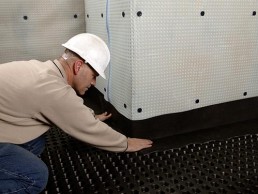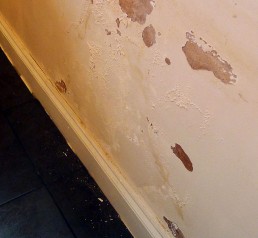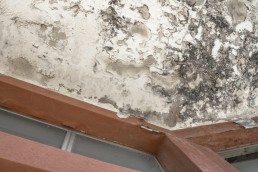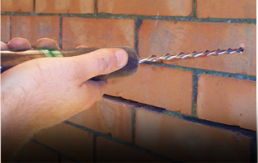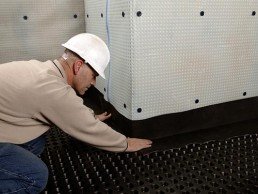How to Install Internal Wall Insulation
If your home has solid stone or brick walls, then you might be wondering how to install internal wall insulation. Solid stone or brick walls are notoriously bad insulators, and it’s estimated that as much as 50 per cent of a building’s heat can be lost through the walls without effective insulation.
Having internal solid wall insulation installed can help your home to conserve heat, keeping your house warm during winter while lowering your energy bills and helping the environment.
If you’re interested in learning how internal solid wall insulation can be installed in your home, the experts at Danford, Brewer & Ives are here to explain.
What Is Internal Wall Insulation?
Internal wall insulation is a type of insulation installed on the interior walls of a building. The main goal of internal wall insulation is to provide an effective insulating barrier that stops heat inside the building from escaping.
Modern homes are commonly built with internal wall insulation as standard, as they’re constructed with cavity walls that create an insulating barrier. However, older homes – particularly buildings dating back to the 1920s and earlier – were often built with only a single, solid wall.
A building with a solid brick or stone wall is going to be incredibly poor at insulating, as heat is easily lost when cold pockets form in the masonry. Having internal solid wall insulation installed is the best way to modernise these older homes, to keep them warm, to save energy and to lower bills.
There are several ways this can be achieved, but the most popular form of solid wall insulation is to have a second layer of wall installed on the inside of the home against the solid brick or stone. This second layer essentially creates a cavity space, which can be filled with insulating materials.
How Do I Install Internal Wall Insulation?
There are different methods of internal solid wall insulation, and the best method depends on a number of factors. This includes the age of your home, the stability of the existing walls, the internal space available, and the budget you have for materials.
For this reason, we always recommend speaking to a professional, as installing internal solid wall insulation is a large and often complex project to undertake. For the majority of older homes, the best option will be to add a second layer of wall, usually constructed from materials such as plyboard or chipboard. This space between the solid wall and the newly added layer of the internal wall needs to be filled with insulating materials; again, the materials can vary. More often than not, foam is the insulator of choice.
In order for the insulation to work, it needs to be installed to a depth of at least 60mm. This is the minimum depth we recommend and, if possible, the solid wall insulation should be installed to create an insulating barrier that’s 100mm in thickness.
Of course, the thicker the internal wall is, the more effective it will be at insulating, but you also need to consider that thicker walls are more costly and take up more space inside the home.
Do I Need a Professional to Install Internal Solid Wall Insulation?
Installing internal solid wall insulation is a large project that requires skill and expertise. A professional can help to highlight the most effective areas where insulation can be installed, allowing your home to be better insulated while saving you money by avoiding unnecessary work on ineffective areas of the property.
Because this can be a disruptive job, professionals also ensure that the work is done smoothly, quickly and to a high standard. There are multiple insulation options that can be considered by homeowners looking to better insulate their property. For example, a professional may suggest that traditional solid wall insulation could be combined with damp proofing work to create the best possible barrier against both moisture and heat loss.
Contact Danford, Brewer & Ives to Find Out More About Internal Solid Wall Insulation
Installing internal solid wall insulation can help you to keep your home warm in winter, save money on energy costs and protect the environment. Due to the complexity of installation and the different options available to homeowners, we always recommend having internal solid wall insulation work carried out by a professional.
For more information and advice on internal solid wall insulation, please contact our friendly team on 01765 804050 or fill in our online contact form. Our experienced specialists will be on hand, ready to offer expert advice tailored to your needs or to arrange a thorough survey of your home.
Rising Damp on Internal Walls
Rising damp is a serious problem that can cause costly damage to a property if left untreated. Luckily, it’s not a problem that homeowners have to deal with often, but it’s still important to ensure that your home is protected against the most common causes of rising damp.
Rising damp can affect both internal and external walls, with internal walls being particularly prone to damage. In this article, the experts at Danford, Brewer & Ives explain how to stop rising damp on internal walls.
What Is Rising Damp?
Rising damp is a flow of vertical water that rapidly spreads from ground level, upwards. It’s one of the three common forms of damp that can affect a property (the other two being penetrating damp and condensation).
Water can work its way through brick walls and masonry, before spreading through a property’s internal walls. Learning how to stop rising damp on internal walls is important, as it can rapidly move through a home using capillary action.
If you notice any of the following signs on your internal walls, you could have a rising damp problem:
- Tide marks on internal walls
- Damp patches on internal walls
- Peeling wallpaper or paint
- Rotting skirting boards, door frames or window frames
- Mould or other fungal growths
- Musty smells
- Corroded bricks
- Discoloured external walls
If you are worried about rising damp on internal walls, it’s a good idea to have a damp specialist carry out a survey. They’ll be able to identify the type of damp and its cause, before recommending a solution.
How to Stop Rising Damp on Internal Walls
There are several ways to stop rising damp, and the exact treatment recommended by a specialist will depend on a number of factors. These include the extent of the rising damp problem, the amount of damage already caused, and where exactly in the home the rising damp problem is.
Treatments for rising damp focus on removing the current source of the damp, such as damp floorboards or rotten timbers, and adding protection to stop rising damp occurring again.
The four most effective ways to stop rising damp on internal walls include:
- Removing the source of the damp, including any damaged plasterwork or skirting boards.
- Removing and replacing rotten floorboards or damp sections of walls affected by the rising damp.
- Injecting a chemical damp proof course into the walls, thereby creating a waterproof barrier to stop rising damp from occurring in the future.
- Removing soil from around the base of an external wall to bring it below any existing damp proof course.
Contact Danford, Brewer & Ives to Find Out More About Stopping Rising Damp
For more information and advice on rising damp on internal walls, please contact our friendly team on 01765 804050 or fill in our online contact form.
Our experienced specialists will be on hand and ready to offer expert advice tailored to resolve your problem.
Rising Damp on External Walls
Rising damp is a serious problem that homeowners need to stop dead in its tracks. Caused by water seeping into brickwork and masonry, rising damp can lead to dangerous structural damage and hazardous health issues such as mould.
Rising damp can affect both external and internal walls, but it’s often more difficult to spot rising damp that’s taken hold on the outside of a building. Learning how to stop rising damp on external walls is important for the safety of your house, so in this article the experts at Danford, Brewer & Ives explain how.
What Is Rising Damp on External Walls?
Rising damp is best defined as an upward movement of water, spreading rapidly from the ground as it moves through walls using capillary action. Rising damp is caused by water seeping into masonry, most commonly from the outside, so it often takes hold on external walls before spreading inside the home.
Rising damp can quickly spread inside from the outside, so learning how to stop rising damp on external walls can help you to contain a damp problem before it causes too much damage. If left untreated, external rising damp can rapidly move inside, causing damage to walls, floors and even ceilings. This can mean costly repairs, structural damage and potentially hazardous mould problems that can prove dangerous to the health of the occupants.
There are several signs you can look for that may indicate you have a rising damp problem on your external walls, including:
- Tide marks on external walls
- Discolouration on external walls
- External walls are damp to touch
- Crumbling masonry or broken brickwork
- Growths of moss on the outside of the home
- Musty, mouldy smells around the home
It’s also possible that you’ll notice damage to the inside of a home, as the rising damp spreads from the outside. You might notice peeling plaster, discolouration, tide marks, damp or mould on internal walls.
How to Stop Rising Damp on Internal Walls
If you notice any signs of rising damp, contact a professional immediately for a damp survey, as they’ll be able to recommend how to stop rising damp on external walls before too much damage has been caused.
The four most effective ways to stop rising damp on external walls are:
- Isolating the source of the damp, be it a broken drainpipe, flooding, etc.
- Removing and replacing damp masonry or bricks affected by rising damp.
- Injecting a chemical damp proof course into the external walls, thereby creating a waterproof barrier to stop rising damp from occurring in the future.
- Removing soil from around the base of an external wall to bring it below any existing damp proof course.
Contact Danford, Brewer & Ives to Find Out More About Rising Damp
For more information and advice on rising damp on external walls, please contact our friendly team on 01765 804050 or fill in our online contact form.
Our experienced specialists will be on hand and ready to offer expert advice tailored to resolve your problem.
Can a Water Leak Cause Rising Damp?
Can a water leak cause rising damp? That’s an important question that our experts at Danford, Brewer & Ives are frequently asked.
The short answer is yes, a water leak can cause rising damp, leading to the growth of mould, rotten floorboards and potentially dangerous structural problems in your home.
Rising damp is a serious problem. In this article, we explain in more detail how water leaks can be troublesome, and when you need to call in the professionals.
What Can Cause Rising Damp?
Rising damp is a vertical movement of water from the ground, upwards. If left untreated, it can quickly spread through a home using capillary action.
Rising damp is a serious problem for homeowners, as it can be difficult to spot before it’s already started to cause damage. It’s most commonly caused by water seeping into the walls, bricks, timbers or masonry of a building, often from the outside.
Once water begins to seep through, it causes damp and mould and can decay timbers, cause crumbling masonry, and rapidly leave behind damage as it makes its way further inside your property.
The cause of rising damp is water, but there can be many different reasons as to why water is seeping into your home. The most common causes are:
- Broken pipes
- Overflowing drains
- Flooding
- Excess groundwater
- Leaks
- A broken damp proof course
Can a Water Leak Cause Rising Damp?
So can a water leak cause rising damp? While there could be many causes for a rising damp problem, it’s common for the main culprit to be a leak.
Leaking pipes or broken drains leaking water into the ground can cause groundwater levels to rise, resulting in rising damp. This can occur even if you have a damp proof course installed, as rising water levels may flow above the level of the waterproof damp proof course.
Leaks may also occur in bathrooms, kitchens, pantries or any other areas where there are taps or pipes. Large leaks caused by burst pipes or broken toilets will be noticed easily, but even small leaks can lead to rising damp. Over time, leaky bathtubs or sinks can result in damp patches forming on the floor, or broken seals on showers can lead to a build up of moisture that can seep into the walls.
If you’re concerned about rising damp, it’s important to call in a specialist quickly. Identifying the cause of a rising damp problem can be difficult, but if there is a leak, this needs to be fixed before it leads to more costly damages.
Contact Danford, Brewer & Ives to Find Out More About Rising Damp
For more information and advice on identifying the causes of a rising damp problem, please contact our friendly team on 01765 804050 or fill in our online contact form.
Our experienced rising damp specialists will be on hand and ready to offer expert advice tailored to resolve your problem.
How to Treat Rising Damp in an Old House
Rising damp can pose a serious problem to homeowners and, if left untreated, can lead to mould, structural damage and health hazards.
In an older house, rising damp is not only more likely to occur, but it can be more difficult to treat than in newer, more modern homes.
If you’re wondering how to treat rising damp in an old house, the experts at Danford, Brewer & Ives are here to explain everything you need to know.
Why Does Rising Damp Affect Older Houses?
Rising damp is best defined as an upward movement of water through the walls of a building. Water moves from ground level upwards using capillary action to rapidly spread through the bricks and masonry of a home.
There can be many reasons as to why buildings are affected by rising damp. Common causes including flooding, excess groundwater, leaks, or broken infrastructure such as drains and pipes.
While these problems can affect all houses, older houses are particularly susceptible because they might not have a protective damp proof course installed. Older houses dating back to the 19th century were not built with a damp proof course, or DPC, which modern houses have as standard. Without a waterproof damp proof course, it’s much easier for water to seep into walls from the outside.
How to Treat Rising Damp in an Old House
Rising damp needs to be treated quickly in order to limit the potential damage it might cause to a property.
In older houses, rising damp commonly occurs because a damp proof course has never been installed. If a damp proof course is installed, then it’s also possible that an old DPC may have failed. If this is the case, the best way to treat rising damp in an old house is to have a new damp proof course installed.
Depending on the extent of the rising damp problem, rotten timbers or damaged sections of wall or masonry affected by the damp may need to be removed and replaced, before a chemical damp proof course is injected into the walls.
Another issue that may need fixing is rising groundwater. Over time, the DPC may slip below the waterline, therefore becoming redundant. If this has occurred, then the soil can be dug out around a home to make the DPC more effective.
A damp specialist can quickly check if there is a damp proof course, or if there is another cause of rising damp. Because of the potential complications and dangers involved when working on older houses, particularly those dating back to the Victorian era or beyond, it’s always recommended to call in a professional specialist if you believe your home might have rising damp.
Contact Danford, Brewer & Ives to Find Out More About Treating Rising Damp
For more information and advice on how to treat rising damp in an old house, please contact our friendly team on 01765 804050 or fill in our online contact form.
Our experienced specialists will be on hand and ready to offer expert advice tailored to resolve your problem.
Will External Wall Insulation Stop Mould?
Mould is a homeowner’s nightmare. This smelly, fungal spore thrives in wet and damp conditions, and is costly to remove as well as having potentially serious effects on the health of the home’s occupants.
There are many ways to damp and mould proof your home, but one of the most effective methods is to install external wall insulation. This is a big structural improvement to a property, so in this article, the experts at Danford, Brewer & Ives examine the effectiveness of external wall insulation in stopping mould.
Here’s our answer to the question, ‘Will external wall insulation stop mould?’
What Is External Wall Insulation?
You might be wondering how external wall insulation could stop mould. After all, aren’t insulating materials designed to insulate, rather than protect against problems like damp and mould?
You’re not wrong. External wall insulation is most commonly installed against solid stone walls. It adds an extra layer to the outside of a home, leaving a cavity space that can be filled with insulating materials. This stops heat from escaping, thereby saving you money on your energy bills while also helping the environment.
External wall insulation has the added advantage of being waterproof. Because it’s installed on the outside of a building, the materials used need to be able to withstand British weather, so they are commonly constructed from resistant, impermeable materials that create a waterproof barrier.
It’s this waterproof feature that ensures external wall insulation can help you to fight mould.
Will External Wall Insulation Stop Mould?
Mould needs moisture to survive. In damp, wet conditions, it’s quite easy for a mould problem to get out of control as it spreads throughout a home.
Mould is commonly caused by water seeping into walls from the outside. With the addition of an external, waterproof layer on the outside of the home, you’re protecting your household against one of the primary causes of mould. If water can’t get inside the walls or into the masonry and timbers, then mould will find it difficult to survive without the moisture it needs.
So, will external wall insulation stop mould? Yes. Although it can be a costly addition to a home, external wall insulation is waterproof and highly effective at combating damp, mould, leaks and seeping water that would otherwise cause damage to your property and could prove hazardous to human health.
The upfront installation costs are generally recouped as you save on repairs and maintenance, too. And don’t forget, the primary goal of external wall insulation is to stop heat from escaping, so you’ll also save significant amounts of energy and money over time.
Contact Danford, Brewer & Ives to Find Out More About External Wall Insulation
For more information and advice on installing external wall insulation, then please contact our friendly team on 01765 804050 or fill in our online contact form.
Our experienced specialists will be on hand and ready to offer expert advice tailored to resolve your problem.
Is a Damp Proof Membrane Necessary?
Damp proof membranes form an effective barrier against moisture. When properly installed, they offer protection against damp, mould and many other serious problems that can affect your property.
Many homeowners wonder if having a damp proof membrane installed is worth the cost, so in this article we explain why a damp proof membrane is so important.
Find out more as the experts at Danford, Brewer & Ives answer the question, ‘Is a damp proof membrane necessary?’
What Is a Damp Proof Membrane?
A damp proof membrane is a thick sheet of waterproof materials, usually plastic composites, which is installed as a barrier to stop water from seeping into a property.
A damp proof membrane, or DPM, is required to be a minimum of 1200 gauge in thickness and is commonly installed above or below floorboards, and on the inside or outside of a property’s walls.
Is a Damp Proof Membrane Necessary?
So, is a damp proof membrane necessary? The short answer is yes, because a damp proof membrane can help protect your home against a variety of potentially serious issues.
As a waterproof barrier, damp proof membranes protect against moisture and water leaking into the walls, floorboards, timbers and masonry. This stops damp from forming, mould from spreading, and fungal spores from taking hold throughout the house.
Without a damp proof membrane, moisture can quickly spread through a property. If left unchecked, issues like damp and mould can cause serious structural problems, they can be costly to repair, and they can prove hazardous to human health.
An effective damp proof membrane, while also protecting against damp and mould, has the added bonus of being a useful insulator. It creates an impermeable barrier, trapping heat and lowering a property’s energy output. This not only helps you to save money on your gas or electric bills, but it’s an excellent way to save resources while helping the environment.
How Effective Is a Damp Proof Membrane?
A damp proof membrane has the potential to create a very effective barrier against moisture and water, but only if properly installed across your property.
Damp proof membranes can be cut to size and installed in such a way that they overlap, meaning there’s no way water can get through and into your home. Damp proof membranes are most effective when they are used in conjunction with a damp proof course and other damp proofing methods.
It’s always recommended to have a damp proof membrane installed professionally. A damp proofing specialist can identify the most strategic locations in your household for installation, ensuring that the damp proof membrane can function as both a waterproof and an insulating barrier.
Contact Danford, Brewer & Ives to Find Out More About Damp Proof Membranes
For more information and advice on installing damp proof membranes, please contact our friendly team on 01765 804050 or fill in our online contact form.
Our experienced specialists will be on hand and ready to offer expert advice tailored to resolve your problem.
Is It Worth Getting External Wall Insulation?
Is it worth getting external wall insulation? That’s a question we often hear at Danford, Brewer & Ives.
We understand why people are concerned, and that’s because external wall insulation can be a major change to the outside structure of your home. Plus it doesn’t come cheap.
However, external wall insulation not only saves you money on your energy bills, but it can help your home become greener and more environmentally friendly. If you’re wondering, ‘Is it worth getting external wall insulation?’ read our guide to its main advantages.
What Is External Wall Insulation?
External wall insulation is designed to add an extra, insulating layer to a home. It’s most commonly installed on top of solid stone walls, which often cause a property to lose large quantities of heat.
External wall insulation creates a cavity space, within which insulating materials can be added. This stops heat from escaping, which in theory lowers your energy bills and saves you money.
Is It Worth Getting External Wall Insulation?
But is it worth getting external wall insulation, considering it’s a costly improvement to a property? Here are the major benefits of having external wall insulation installed:
- Keep your home warm in winter
- Save money on energy bills
- Help the environment
- Protect against damp and mould
- Change the outside look of your home
As you can see, there are several advantages to be gained from installing external wall insulation. You save energy but your home stays warmer in winter, while you’re also playing your part in helping the environment by lowering your carbon footprint.
As well as being a great insulator, external wall insulation also has the added advantage of protecting against damp and mould. External wall insulation is waterproof, and it creates an impermeable barrier that stops water from seeping into your home. As a further bonus, external wall insulation can be stylish. It could be the smart new addition you need to tidy up the exterior of your property.
For many customers, the most important factor is cost. Financially, is it worth getting external wall insulation?
There’s no doubt that external wall insulation is a major addition to your property, and that comes with associated costs – particularly if you want the work carried out professionally and with the best materials. However, external wall insulation is guaranteed to save you money on your energy bills. Over several years, you’ll make back the upfront costs and then start saving, while the value of your property is certainly going to improve, too.
Contact Danford, Brewer & Ives to Find Out More About Installing External Wall Insulation
For more information and advice on installing external wall insulation, then please contact our friendly team on 01765 804050 or fill in our online contact form.
Our experienced specialists will be on hand and ready to offer expert advice tailored to resolve your problem.
What Does a Damp Proof Membrane Do?
Homeowners looking to protect their property should always ensure that there’s a damp proof membrane installed.
A damp proof membrane is a cost-effective way to avoid serious problems, such as damp, mould, rot, and more, while also helping to save energy by keeping houses insulated.
If you’re wondering whether your home needs a damp proof membrane, read on as the experts at Danford, Brewer & Ives answer the important question, ‘What does a damp proof membrane do?’
What Is a Damp Proof Membrane?
A damp proof membrane is an effective form of waterproofing that creates a protective barrier against damp and moisture. A damp proof membrane commonly consists of a durable sheet of plastic material produced to a government-regulated thickness that’s a minimum of 1200 gauge.
A damp proof membrane should always be installed by a damp proofing specialist, as it should be installed in key locations throughout a property. A damp proof membrane can be installed either above or below the floor or against the interior or exterior of a property’s walls.
What Does a Damp Proof Membrane Do?
So what does a damp proof membrane do? The main purpose of a waterproof damp proof membrane is to stop moisture from seeping into the walls, floors, timbers or masonry of a building.
By creating a waterproof barrier in strategic locations, a damp proof membrane protects a home against the potential dangers created by damp and moisture.
Damp can swiftly move through a building if there’s no protection against it, using capillary action to move from one wall to the next. If left untreated, damp can cause serious structural damage, wood rot, mould and fungal infections. Many of these issues can be costly to repair, while damp and mould can be hazardous to human health, too.
Importantly, damp proof membranes also act as useful insulators. When installed against walls or below floorboards, damp proof membranes act as insulating barriers, trapping heat and saving energy.
The energy-saving capacity of a damp proof membrane ensures that it’s a cost-effective addition to a home. Over time, the cost of the installation is generally recouped and exceeded by the potential energy savings that can be made over the course of several years.
How Effective Is a Damp Proof Membrane?
A damp proof membrane forms a protective barrier against problems like damp, mould and condensation.
However, for a damp proof membrane to be at its most effective, it should always be installed by a professional. A damp proof membrane can be installed in such a way that individual sheets overlap with one another; this ensures there are no gaps, and that your home is protected by an impermeable barrier.
Contact Danford, Brewer & Ives, to find out more about damp proof membranes.
For more information and advice on installing damp proof membranes, then please contact our friendly team on 01765 804050 or fill in our online contact form.
Our experienced specialists will be on hand and ready to offer expert advice tailored to resolve your problem.
How Can I Save Energy in My Home?
Saving energy in the home is not only an excellent way to lower energy bills, but it’s a fantastic way to help the environment, too.
From installing extra loft insulation to having solid walls insulated, there are lots of effective ways to save energy in your home.
Savvy homeowners are always looking for ways to save money and lower their energy bills. To help you, the experts at Danford, Brewer & Ives explain the best ways to save energy in the home.
Why Is Saving Energy at Home So Important?
Saving energy has become an important aspect of being a homeowner. High-energy usage always results in higher energy bills – and that costs money.
In almost all cases, high-energy output can be put down to poor insulation. Large quantities of heat are lost through the walls and roof. Insulating them therefore allows heat to be retained inside the home, thereby lowering the amount of gas or electricity needed to keep the home at a constant temperature. Lower energy use then means lower bills.
Perhaps just as important as saving money are the environmental impacts attached to energy saving. Saving energy by making your home more energy-efficient ensures that you consume fewer resources in the long term. In an age of dwindling energy supplies, this is a big help for the planet.
What Are the Best Energy-Saving Methods?
Energy-saving can be as simple as keeping windows and doors closed when the heating is on in winter, but to create a truly energy-efficient home, it’s important to look beyond this.
A well-insulated home is an energy-efficient home. Making improvements to a building’s structure or insulating capabilities is guaranteed to lower energy bills and save you money in the long term.
Here at Danford, Brewer & Ives, our energy-saving experts have identified the best ways to save energy in the home. The following are the most efficient ways to make changes to a building for long-term energy-saving wins:
- Solid stone wall insulation
- Solid brick wall insulation
- Internal wall insulation
- Brick wall waterproofing
- Masonry waterproofing cream
- Damp proof course
- Loft insulation
Different homes require different approaches to energy saving, so it’s important to seek professional advice if you’re looking to make energy-saving changes. While older Victorian houses will benefit the most from having solid stone wall insulation installed, more modern houses may benefit from having more effective loft insulation installed below the roof.
Let’s take a look at the different energy-saving methods in more detail, so you can understand which approaches would work best and be most effective in your home.
Solid Stone Wall Insulation
Solid stone walls were a common feature of houses in the United Kingdom during the Victorian era, and many older houses still retain solid stone walls to this day. While solid stone walls are sturdy and easy to build, as insulating and heating techniques have become more effective, it’s become apparent that solid walls are incredibly poor insulators.
Solid stone walls have no space where hot air can be trapped. This means that heat from inside the home easily escapes through the walls. Solid stone is a poor insulator and cold pockets quickly form in winter, causing the house as a whole to become colder and requiring a much higher energy output to keep the home heated.
But older houses with solid stone walls can be brought up to date and made energy efficient with the addition of solid stone wall insulation. This involves an extra insulating material being attached to the inside or outside of the wall, leaving a gap between the stone wall and the new layer of material. The cavity space that’s created is then filled with insulating materials (such as insulating foam). This method is incredibly effective, as the cavity space traps hot air, keeping homes warmer for longer and significantly lowering energy usage.
Solid Brick Wall Insulation
Solid brick walls have exactly the same insulating problems as solid stone walls, and they are a common feature of older houses dating back to the Victorian era.
Solid brick walls are constructed from a single layer of brick, and that makes insulation very difficult. Hot air can’t be trapped and it simply escapes to the outside, thereby forcing a homeowner to spend more money keeping their home’s temperature constant.
Solid brick walls can be considerably improved with the addition of solid brick wall insulation. This is achieved through the addition of an extra layer of material to the wall, usually inside the home. This extra layer creates a cavity – a space that’s filled with insulating materials.
As the cavity space traps hot air, energy usage is lowered. Heat remains inside the home, rather than dissipating to the outside. Solid walls are the worst possible insulators, so anyone with solid brick walls can save huge amounts of energy by having solid brick wall insulation installed.
Internal Wall Insulation
Modern homes are no longer built with solid walls, but are ordinarily constructed with cavity walls specifically designed to insulate the building. However, homes can still lose as much as 50 per cent of their energy through the walls, particularly if poor quality insulation was installed or if the insulation has been damaged.
If your home is particularly cold, you have high energy bills or can feel cold spots on the walls, there’s a good chance you need extra internal wall insulation installed. In older buildings, there’s also a chance that no internal wall insulation has ever been installed previously – this is a common occurrence if walls have been built from solid stone or solid brick.
Internal wall insulation generally consists of effective insulating materials – such as foam boards – being used to line the interior walls of a home. This adds much needed extra insulation, and that allows heat to be retained and energy savings to be made.
Brick Wall Waterproofing
Heat escaping through the walls isn’t the only problem that homeowners face when insulating their homes. Brick walls, as well as being insulated, also need to be waterproofed in order to be as energy-efficient as possible.
If brick walls aren’t adequately sealed, then porous bricks allow water to flow from the outside in. This not only allows cold spots to form but it disrupts cavity insulation, as wet insulation does not trap heat well. Prolonged exposure to moisture also leads to more serious damp and mould problems, which can be costly to fix. Damp and mould have the potential to cause serious structural issues to a home, while they can also lead to respiratory illnesses if residents are exposed for an extended period of time.
Brick wall waterproofing is the best solution for sealing brickwork. Waterproofing involves a sealant or cream being applied to the external walls of a house, where brickwork is exposed to the elements. Brick wall waterproofing is cost effective and long lasting, and energy savings are made as walls remain waterproofed and well insulated.
Masonry Waterproofing Cream
Masonry waterproof cream is another solution for homeowners needing to seal their walls to protect against damp.
Masonry waterproofing cream can be applied to external walls that let water into a home. The cream can be applied to a variety of masonry materials to create an effective waterproof seal that acts as a barrier to water and moisture.
Masonry waterproofing is long lasting and protects against issues such as damp and mould, which are caused by water seeping through walls. Waterproofing helps homeowners to save energy, as insulating materials are protected against moisture while an added layer helps to stop heat from escaping. With less heat escaping, homeowners can save money on their energy bills thanks to masonry waterproofing cream.
Damp Proof Course
Damp problems are a major cause of energy loss, as damp walls and floors are incredibly poor insulators. Damp is often the result of water or moisture working its way into the home from outside the building. The best way to combat this is by having a damp proof course installed.
A modern damp proof course has to be injected into the masonry. This creates a waterproof seal that stops water from seeping through into the walls from outside the building.
A damp proof course keeps homes watertight, which ensures walls and floors are fully protected against leaks, moisture and dampness. In turn, this ensures that the insulation in the walls isn’t wet or damp, allowing it to do its job and stop hot air from escaping. A damp proof course then is an effective way to save energy by keeping your home insulated.
As well as keeping energy bills low, homeowners should consider that a damp proof course is vital for a healthy home environment. If damp is allowed to take hold in a home, it can lead to structural dangers as well as issues such as mould, all of which are hazardous to human health.
Modern homes are fitted with a damp proof course as standard, but they need to be inspected regularly and replaced if they have moved or been damaged.
Loft Insulation
As much as 25 per cent of a home’s energy loss can occur through the roof, so it’s important for homeowners to insulate their lofts.
Loft insulation techniques vary, as it depends on the available space and whether or not the loft is used for storage or has been converted.
For large loft spaces that aren’t in use, the simplest insulation method is filling the open space with insulating materials. This turns the loft into an effective insulator, as hot air that rises is trapped by the insulating materials. Rather than escaping through the roof, the hot air keeps the house warm for longer.
Many people choose to use their loft as a storage space or an extra room. If this is the case, then it’s not possible to fill the loft with foam insulation. Instead, a second layer of flooring can be added, usually made of plyboard or similar materials. This creates a cavity space that can be filled with insulation. Hot air is trapped and the house remains warm, while the loft can still be used as a storage space.
The inside of the roof can also be lined with insulation in the same way, a technique that keeps the loft space warm. This is the best method if the loft has been converted into a living space or extra bedroom.
Energy-Saving Surveys
The methods outlined in this article require professional installation to ensure they are installed correctly. Some energy-saving methods, particularly solid wall insulation, can be disruptive to install, so it’s important to make sure that this is the best method for your home before work begins.
For these reasons, we recommend having an energy-saving survey carried out on your property. Energy-saving experts can identify the best areas to make improvements, and recommend the most cost-effective methods where the biggest energy-saving gains can be made.
Danford, Brewer & Ives has a specialist energy-saving team that carry out surveys and can identify the best ways to save energy. We understand that every home is different, so every survey needs to be tailored to each property. Our team provides analysis and recommendations, before we then carry out the work needed to make your home energy efficient.
Costs for energy-saving work vary from one home to the next, but energy-saving improvements should always be seen as an investment. Upfront costs for work will be recouped through lower energy bills in the long term, while you’ll also be helping the environment by lowering your home’s energy usage.
Contact Danford, Brewer & Ives to Find Out How You Can Save Energy in Your Home
If you’re looking to lower your energy bills by improving your home’s insulation, then the team at Danford, Brewer & Ives are ready to help you.
Contact our friendly, professional staff for more information on the best ways to save energy, and to book your energy saving survey today.

